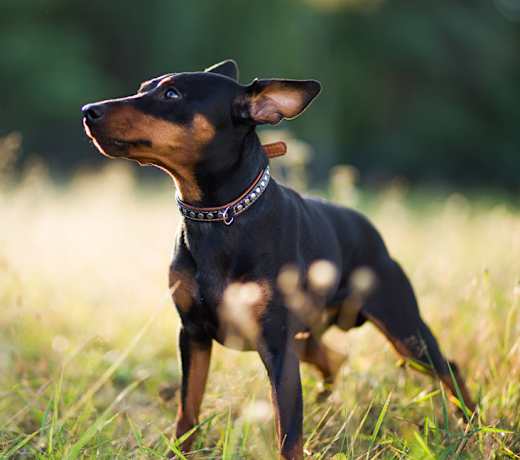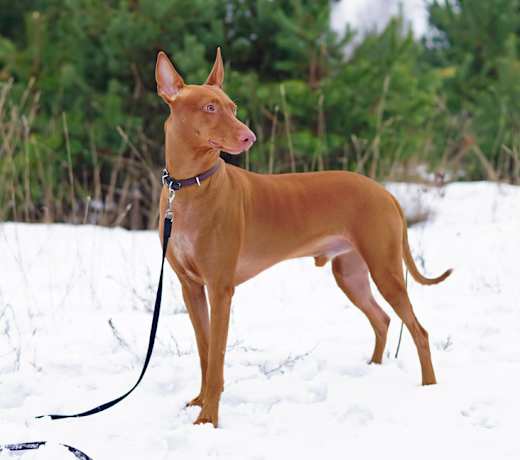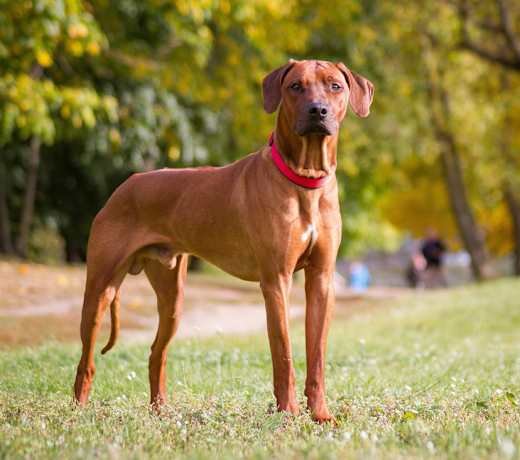Dobermans typically stand around 24 to 28 inches in height at the shoulder and weigh between 60 to 117 pounds, with males being larger than females. These size ranges are typical for the breed, but individual Dobermans can vary slightly in size based on genetics and other factors.
Doberman Pinscher
Breed Type: Working
Common nicknames: Doberman, Dobie
Coat: Smooth
Hypoallergenic: No, they will likely trigger allergies.
Temperament: Loyal, intelligent, protective, energetic
Life expectancy: 9-12 years
Color & patterns:
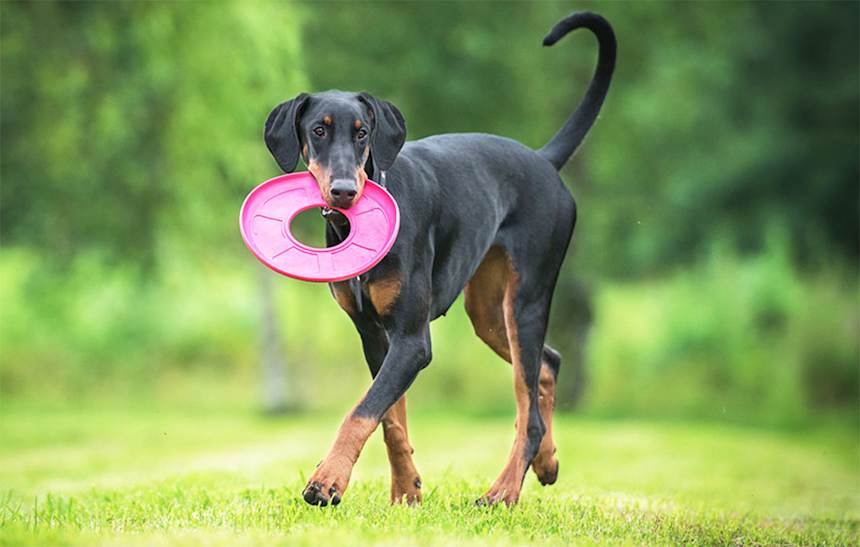
Dobermans may be known for their sleek and intimidating appearance, but they have a charming and silly side that’s impossible not to love. These dogs are incredibly loyal and affectionate with their families, often following them from room to room like a shadow. They are playful and energetic and love nothing more than a good game of fetch or tug-of-war. One of the Doberman’s most distinctive features is their intelligence and trainability. They are quick learners and excel in a variety of activities, including obedience training, agility, and even therapy work. Despite their reputation as fierce guard dogs, Dobermans are actually quite sensitive and loving, making them the perfect companion for those who value both security and affection. If you’re up for investing in obedience training, agility, and other dog sports, your Doberman will be up for it all.
Doberman Pinscher characteristics
Learn about about Doberman Pinscher basics like their fur colors, shedding levels, how much grooming they need, and other Doberman Pinscher facts.
Average height
24-28 inches (61.0-71.1cm)
Average weight
60-117 pounds (27.2-53.1 kg)
Average lifespan
9-12 years
Exercise needs
Grooming needs
Full-grown size
Good with cats
Good with kids
Training aptitude
Do Dobermans shed a lot?
Yes, Dobermans shed but are considered low to moderate shedders with their short, sleek coats. While they do shed, it’s generally less noticeable compared to breeds with longer or denser coats. Some Dobermans can experience seasonal increases in shedding, particularly during spring and fall. Regular brushing can help minimize shedding and keep their coat healthy.
What colors do Dobermans come in?
Dobermans come in a few standard coat colors, primarily black and rust (black with reddish-tan markings) and blue and rust (blue-gray with rust markings). Some less common colors include fawn (a yellow-gold with rust markings) and red (a solid reddish-brown). These colors are often found alongside the breed’s signature markings on their face, chest, legs, and tail. White Dobermans also exist but are considered a genetic abnormality and are not recognized by breed standards.
What is the rarest Doberman color?
The rarest Doberman color is white. White Dobermans result from a genetic variation known as albinism, which inhibits the production of pigment in their coat, eyes, and nose. White Dobermans are not recognized in official breed standards and are typically a result of poor breeding practices. White Dobermans may have potential health issues linked to albinism, such as poor vision, sensitivity to sunlight, and a significantly increased risk of skin tumors.
What is the rarest breed of Doberman?
All-black Dobermans, often referred to as melanistic Dobermans, are one of the rarest Dobermans. Their black coat lacks color points (or markings) and results from a genetic mutation that leads to a surplus of melanin, which is responsible for their dark coloration.
How long does a Doberman live?
The average lifespan of a Doberman is between 10 to 13 years, although individual longevity can vary. Factors that can influence a Doberman’s lifespan include genetics, diet, exercise, and overall health. Responsible breeding practices and regular veterinary check-ups can also contribute to a longer and healthier life for a Doberman.
What breeds make a Doberman?
The breeds that make a Doberman include the Rottweiler, Greyhound, Weimaraner, and German Pinscher. These breeds were carefully selected for specific traits, resulting in the creation of the Doberman breed known for its loyalty, intelligence, and protective nature.
When does a Doberman stop growing?
Dobermans reach their full height by 12 months of age, but they may continue to fill out and develop muscle mass until they are about 18 to 24 months old. While they may reach their adult size relatively early, their growth and development, both physically and mentally, continue during this period. Proper nutrition and exercise during their growth phase are crucial to ensure they develop into healthy and well-proportioned adults.
Are Dobermans hypoallergenic?
No, Dobermans are not considered hypoallergenic. They have a short coat that sheds minimally, but they still produce allergenic proteins found in their dander, saliva, and urine that can trigger allergies in sensitive individuals. While some people with mild allergies might tolerate Dobermans better than long-haired or heavy-shedding breeds, no dog breed is entirely hypoallergenic. Regular grooming and cleaning can help reduce allergen exposure.
How many types of Dobermans are there?
There is one type of Doberman recognized by AKC breed standards, but there are two variations based on their appearance: the American Doberman and the European Doberman. The American Doberman is often considered sleeker with a more refined appearance, while the European Doberman is typically larger and more muscular.
Doberman Pinscher health
Learn about about the Doberman Pinscher health outlook and what diseases they may be prone to at various stages of their life.
Is it normal for my Doberman to sleep a lot?
Yes, it can be normal for your Doberman dog to sleep a lot, especially compared to a human sleeping schedule. Although they tend to sleep less than lower-energy, less vigilant breeds, they still need about 14 hours of sleep per day. If your Doberman is sleeping more than usual, especially if accompanied by other concerning signs (such as refusing to eat or eating less), you should consult with your vet.
Why do people crop Doberman ears?
People crop Doberman ears for aesthetic reasons. Historically, ear cropping was believed to reduce the risk of ear infections in working dogs, as it increased airflow to the ear canal. Aesthetically, it was thought to enhance the breed’s alert and imposing appearance. Ear cropping is a controversial practice and has been banned or restricted in many countries due to animal welfare concerns. There is no medical reason to crop a dog’s ears, and vets do not recommend it.
Do Dobermans need grooming?
Yes, Dobermans need grooming but it is very minimal. Dobermans have a short, fine coat that naturally sheds dirt and stays relatively clean, so they don't require frequent baths. Regular brushing, about once a week, helps remove loose hair and maintain their coat’s health and shine. Dobermans also need routine nail trimming, teeth cleaning, and ear cleaning.
What do Dobermans usually die from?
The most prevalent cause of death among Dobermans is Dilated Cardiomyopathy (DCM), a heart condition. Additionally, cancer, particularly hemangiosarcoma and lymphoma, is a significant threat. Other common causes of mortality include issues like bloat, kidney disease, and liver problems. Responsible breeding practices and regular veterinary check-ups can help identify and address these health issues early, potentially extending a Doberman’s lifespan.
Do Dobermans have health problems?
Yes, Dobermans have health problems that they’re prone to, including:
Hip and elbow dysplasia: These are common skeletal diseases in dogs, causing joint abnormalities that can lead to pain, lameness, and osteoarthritis. Surgery can help if diagnosed early.
Heart problems: Dilated Cardiomyopathy (DCM), an enlarged heart, is the most common heart issue affecting Dobermans and affects this breed more than any other. Congestive heart failure is also a concern.
Von Willebrand’s disease: Von Willebrand’s disease (vWD) is the most common inherited bleeding disorder seen in dogs. Dogs with this disease lack a protein necessary for blood clotting, potentially leading to hemorrhages. The deficient protein is called von Willebrand factor (vWF).
Wobbler syndrome: More formally known as cervical vertebral instability, this condition is suspected to be genetically passed down in Dobermans. Dogs affected by wobbler’s syndrome suffer from a malformed spinal canal or instability of the cervical vertebrae. Extreme symptoms are neck pain and paralysis of the legs, but not all dogs are seriously affected. Surgery is available as a treatment option, though the condition recurs in some dogs.
Other: Dobermans are also at risk for bloat (when a dog’s stomach fills with gas, food, or fluid, causing it to twist), albinism (a lack of melanin and pigmentation), and compulsive behavioral issues. Dobermans are also more prone to prostate disease than any other breed. To identify some of these potential issues, a veterinarian may recommend joint, heart, and DNA tests for your Doberman.
Doberman Pinscher temperament
Learn about about the Doberman Pinscher temperament and how well they fit into your lifestyle, home environment, and family.
Can a Doberman live in an apartment?
Yes, a Doberman can live in an apartment, but you should take careful consideration of their exercise needs and the limited space. They are a medium to large breed and have high energy levels, so regular exercise, including daily walks and playtime, is essential to keep them mentally and physically stimulated. Apartments can work for Dobermans if pet parents provide ample exercise opportunities and mental enrichment.
Are Dobermans good dogs?
Yes, Dobermans are considered good dogs for the right pet parent. They are known for their loyalty, intelligence, and protective instincts. Their energetic and alert nature, coupled with their trainability, also makes them versatile working dogs. However, Dobermans require proper socialization, training, and regular exercise to thrive.
Are Dobermans good with kids?
Yes, Dobermans are good with kids. Their loyalty and protective instincts can make them watchful over kids, and they often form strong bonds with them. However, early training and consistent supervision are crucial to ensure that the Doberman’s natural energy and strength are appropriately channeled during play. It’s important for pet parents of any breed to teach their dogs how to gently interact with children.
As with any breed, it is also recommended that your child is always supervised when interacting with your Doberman to keep both the child and dog safe.
Are Dobermans easy to train?
Yes, Dobermans are easy to train when positive and consistent training methods are used. They consistently rank among the top breeds in obedience training due to their innate intelligence and quick responsiveness to their trainers. While the Doberman’s strength and protective instincts may seem intimidating, their natural inclination to be responsive and loyal makes the training process fairly straightforward. Just keep in mind that even if a certain dog breed is known to be easy to train, training any dog requires a long-term commitment.
How much exercise does a Doberman need?
Dobermans need a lot of exercise, and will benefit from at least 60 to 90 minutes of physical activity each day. This can include brisk walks, runs, playtime, and other stimulating activities. This high-energy breed also thrives on mental challenges and benefits from training sessions or puzzle toys to keep their minds engaged. Adequate exercise and mental stimulation are vital to keep Dobermans physically healthy and mentally content.
Do Dobermans bark a lot?
Yes, Dobermans bark a lot and can be vocal when they sense a potential threat or when they’re excited. Their natural protective instincts and alertness can lead to barking, but this behavior can be managed through training and socialization. Properly trained and socialized Dobermans are often less prone to excessive barking, making them good at distinguishing real threats from everyday occurrences.
Can a Doberman be a service dog?
Yes, a Doberman can be a service dog. Dobermans’ intelligence, loyalty, and trainability make them suitable candidates for service work, and their protective nature can be an asset in specific roles. All service dogs must undergo extensive training to assist individuals with disabilities, such as guide dogs for the visually impaired, mobility assistance dogs, and psychiatric service dogs.
Are Dobermans good with other dogs?
Yes, Dobermans can be good with other dogs, but their social compatibility depends on factors like early socialization, individual temperament, and the other dog’s personality. Socialization from a young age is important to ensure they interact well with other dogs. While Dobermans can be assertive and protective, early and positive experiences with other dogs can help them become well-adjusted and social animals.
Are Dobermans smart?
Yes, Dobermans are super smart. They’re ranked among the top breeds for intelligence and responsiveness to training. Their natural intelligence, combined with their loyalty and alertness, makes them quick learners and problem solvers. Dobermans excel in various canine activities and are often used in roles that require intelligence and adaptability, such as search and rescue, police work, and assistance dogs for people with disabilities.
Are Dobermans good family dogs?
Yes, Dobermans are good family dogs. Their intelligence and protective instincts can make them excellent companions and guardians, provided they receive the necessary attention, exercise, and socialization. Early training and exposure to various people and situations are important to ensure that they interact well with family members and other pets.
Are Dobermans good with cats?
Yes, Dobermans can be good with cats. Early socialization and training are the keys to building a happy relationship between Dobermans and cats. Some Dobermans might take to cats easily, while others may need a bit more time and supervision to make sure everyone gets along. Their natural hunting instincts may tempt them to chase cats and other small animals but their individual personality and past experiences play a large role so it’s a good idea to keep an eye on their interactions.
Doberman Pinscher history
Learn about where the Doberman Pinscher came from.
What were Dobermans bred for?
Dobermans were originally bred for the purpose of creating a loyal and protective breed that could serve as a personal security and guard dog. They were specifically designed to be strong, intelligent, and fearless, making them ideal for guarding property, working with police and the military, and serving as loyal companions.
Where do Dobermans come from?
Dobermans originated in Germany in the late 19th century. They were developed by a German tax collector and dog breeder named Louis Dobermann, who aimed to create a loyal and protective breed for personal safety during his work. He used various breeds like the Rottweiler, German Pinscher, Greyhound, and Weimaraner in their development. The result was a sleek, intelligent, and highly trainable breed known for its loyalty and protective instincts, making Dobermans excellent guard and working dogs.
Popular Doberman Pinscher mixes
The breeds that mix with Dobermans include German Shepherds (Doberman Shepherd), Labradors (Doberdor), and Rottweilers (Rotterman). Other breeds that mix with Dobermans include:
Beagleman (Beagle + Doberman Pinscher)
Doberdane (Doberman Pinscher + Great Dane)
Dobergese (Doberman Pinscher + Portuguese Water Dog)
Doodleman (Doberman Pinscher + Poodle)

Find Doberman Pinscher puppies near you
Adopting a Doberman Pinscher
Learn about acquiring a Doberman Pinscher - the pros and cons of adopting versus going through a breeder, and associated costs.

Mocha
Doberman Pinscher Golden Retriever
Male, 3 yrs 8 mos
Los Angeles, CA
Spayed or Neutered
Shots are up-to-date

Gia
Doberman Pinscher
Female, 4 yrs 8 mos
Los Angeles, CA
Shots are up-to-date

Isabella
Doberman Pinscher German Shepherd Dog
Female, 1 yr 7 mos
Los Angeles, CA
Good with dogs
Spayed or Neutered
Shots are up-to-date

Ruby
Doberman Pinscher German Shepherd Dog
Female, 1 yr 7 mos
Los Angeles, CA
Good with dogs
Spayed or Neutered
Shots are up-to-date

Phineas
Doberman Pinscher
Female, 11 mos
los angeles, CA
Good with dogs
House-trained
Spayed or Neutered
Shots are up-to-date

Jett
Doberman Pinscher
Female
los angeles, CA
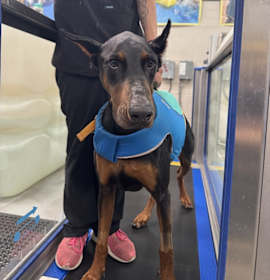
Kobe
Doberman Pinscher
Male, 5 yrs 3 mos
los angeles, CA
Good with dogs
House-trained
Spayed or Neutered
Shots are up-to-date

Laurel
Doberman Pinscher
Female, 3 yrs 1 mo
Beverly Hills, CA
House-trained
Spayed or Neutered
Shots are up-to-date

Mocha
Doberman Pinscher Golden Retriever
Male, 3 yrs 8 mos
Los Angeles, CA
Spayed or Neutered
Shots are up-to-date

Gia
Doberman Pinscher
Female, 4 yrs 8 mos
Los Angeles, CA
Shots are up-to-date

Isabella
Doberman Pinscher German Shepherd Dog
Female, 1 yr 7 mos
Los Angeles, CA
Good with dogs
Spayed or Neutered
Shots are up-to-date

Ruby
Doberman Pinscher German Shepherd Dog
Female, 1 yr 7 mos
Los Angeles, CA
Good with dogs
Spayed or Neutered
Shots are up-to-date

Phineas
Doberman Pinscher
Female, 11 mos
los angeles, CA
Good with dogs
House-trained
Spayed or Neutered
Shots are up-to-date

Jett
Doberman Pinscher
Female
los angeles, CA

